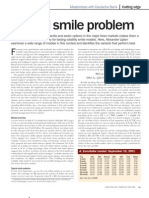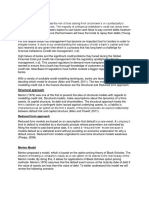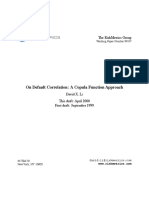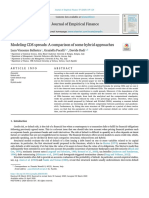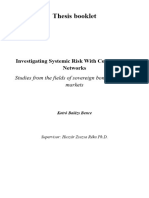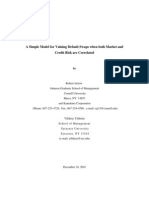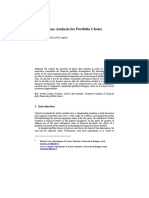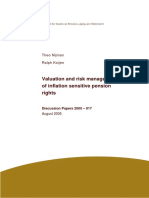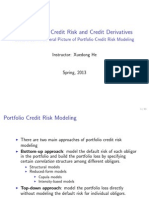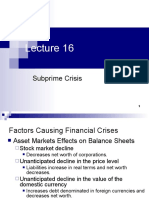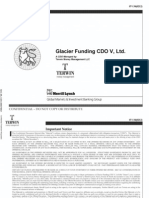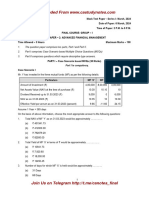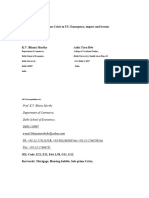CDO Correlation Smile/Skew in One-Factor Copula Models: An Extension with Smoothly Truncated α-Stable Distributions
CDO Correlation Smile/Skew in One-Factor Copula Models: An Extension with Smoothly Truncated α-Stable Distributions
Uploaded by
Eric CellierCopyright:
Available Formats
CDO Correlation Smile/Skew in One-Factor Copula Models: An Extension with Smoothly Truncated α-Stable Distributions
CDO Correlation Smile/Skew in One-Factor Copula Models: An Extension with Smoothly Truncated α-Stable Distributions
Uploaded by
Eric CellierOriginal Title
Copyright
Available Formats
Share this document
Did you find this document useful?
Is this content inappropriate?
Copyright:
Available Formats
CDO Correlation Smile/Skew in One-Factor Copula Models: An Extension with Smoothly Truncated α-Stable Distributions
CDO Correlation Smile/Skew in One-Factor Copula Models: An Extension with Smoothly Truncated α-Stable Distributions
Uploaded by
Eric CellierCopyright:
Available Formats
CDO Correlation Smile/Skew in One-Factor Copula Models:
An Extension with Smoothly Truncated -Stable Distributions
Michael Schmitz,
Markus Hochstotter, Svetlozar T. Rachev
Michael Schmitz
Statistics, Econometrics and Mathematical Finance, School of Economics and
Business Engineering, University of Karlsruhe and KIT
Email: michael@schmitzquadrat.de
Markus H ochstotter
Statistics, Econometrics and Mathematical Finance, School of Economics and
Business Engineering, University of Karlsruhe and KIT
Email: markus.hoechstoetter@kit.edu
Svetlozar T. Rachev
Chair of Statistics, Econometrics and Mathematical Finance, School of
Economics and Business Engineering, University of Karlsruhe and KIT, and
Department of Statistics and Applied Probability, University of Cali- fornia,
Santa Barbara, and Chief-Scientist, FinAnalytica INC Kollegium am Schloss,
Bau II, 20.12, R210, Postfach 6980, D-76128, Karlsruhe, Germany
Email: zari.rachev@kit.edu
Abstract
We propose a one-factor model for credit derivatives with smoothly
truncated stable distributed factors which combines the parsimony of
the copula model structure with the exibility of stable distributions.
The one-factor copula model has become the market standard to
price CDOs and tranched CDS index products. But the use of the nor-
mal distribution, as well as many alternatives as factor distributions,
has lead to poorly reproduced market tranche spreads which resulted
in the well-known correlation smiles. This short-coming is cured to a
sucient extent by our model.
1
1 Introduction
In the last decade, the market for credit derivatives has grown immensely.
1
This development has been accompanied by the emergence of various valua-
tion techniques and models for credit risk. In addition to the attractiveness
of credit derivatives for risk management, an important reason for the nu-
merous publications is without doubt the fact that the recent years have
been challenging for these nancial products. For example, the extensive use
of credit derivatives (in particular credit default swaps (CDS)) is conceived
as one of the factors of the correlation crisis in 2005 and the subprime
mortgage crisis in 2007.
Investors and insurance companies suered huge losses, and the impact of
these crises is still perceptible in almost all economies throughout the world.
In May 2005, the derivative models went through a very tough test trig-
gered by a downgrading of Ford and General Motors in April and May of
2005, respectively. The sharp rise in idiosyncratic risk coincided with CDS
spreads widening to record levels.
It is common knowledge that the simple basic models are not capable of
reproducing market prices correctly. A common phenomenon encountered in
this context is the so-called correlation smile occuring when a correlation co-
ecient is estimated for each tranche to match the respective market spreads.
On the other hand, more advanced models quickly become too dicult han-
dle. The more sophisticated a model is, the more likely it will be liable
to overtting and thus becoming too inexible for changes. A multitude of
parameters often face an insucient data basis for estimation. For these
reasons, many authors such as, for example, Collin-Dufresne et al. (2001),
prefer simple models as given by the one-factor copula model.
Before we proceed into the model itself, we briey introduce the concept
of a particular nancial instrument for credit risk, the synthetic credit default
obligation (CDO). In brief, the synthetic CDO is a securitization of a pool
of credit default swaps (CDS) related to certain reference entities or titles.
Since the value of each CDS depends on the probability of default on the
entity it is contingent on, the entire construct of the synthetic CDO will
consequently be determined by the joint probability of default of the entirety
of the titles.
1
See, for example, Wang et al. (2006)
2
2 One-factor Copula Model
2.1 Valuation of Credit Derivatives
In contrast to the rm-value approach rst conceived by Merton (1974) based
on the value of the underlying entity issuing the bond which is modeled as a
geometric Brownian motion and still developed further such as by Hull et al.
(2009), the reduced-form or intensity-based model presented in Li (2000)
and Due and Singleton (2003), for example, concentrates directly on the
probability of default of the bond within a given period of time. We will
follow the second approach.
The probability of default obtained from the homogenous Poisson process
with intensity representing the distribution of the credit event of some
defaultable zero-bond related to the exponentially distributed inter-arrival
time between two successive jumps (i.e., credit events) is denoted as
F(t, ) = 1 e
(Tt)
(1)
that is the conditional probability of default within the next T units of time
conditional on t units of time with no default. Consequently, the conditional
survival probability of the next T units of time is given by
S(t, ) = 1 F(t, ) = e
(Tt)
(2)
The so-called credit triangle unique to the intensity-based model of the
recovery rate, R, the CDS spread, s
CDS
0
(T), and the default intensity, ob-
tained from the equality of the present values of premium and protection legs,
i.e., the expected present values of payments of the respective counterparties,
is given by
=
1
ln
_
s
CDS
0
(T)
1 R
+ 1
_
. (3)
where spread payments are made at the discrete dates t
k
, k = 1, . . . , v,
with a constant time-lag of = (t
k
t
k1
) between any two successive pay-
ment dates and the additional assumption that defaults can only happen at
the spread payment dates. The proof of (3) can be found in the Appendix.
To relate the payments connected to tranche i with attachment and de-
tachment points K
i1
and K
i
to its market spreads, we introduce the single
3
tranche (STCDO). Then, with the relative portfolio loss L(t) the percentage
loss of tranche i is given by
K
i1
;K
i
(L(t)) =
(max[0, L(t) K
i1
] max[0, L(t) K
i
])
K
i
K
i1
(4)
from whence as a consequence of the equality of the present values of the
premium and proctection leg we compute the tranche spread
s
STCDO
K
i1
;K
i
(0, T)
v
k=1
B(0, t
k
) [E
i
(L(t
k
)|F
0
) E
i
(L(t
k1
)|F
0
)]
v
k=1
B(0, t
k
) [1 E
i
(L(t
k
)|F
0
)]
(5)
with B(0, t
k
) denoting the zero bonds maturing at t
k
. In the approximation
(5), we used the notation E
i
(L(t
k
)|F
0
)= E(
K
i1
;K
i
(L(t
k
))|F
0
). F
0
is the
information at time t
0
.
2.2 Extensions of the One-Factor Model
The one-factor model from Vasicek (1987) builds on the concept the so-called
Large Homogeneous Portfolio (LHP) model, a widely used market standard
for the credit index families CDX and iTraxx as it is easy to understand and
implement. It has been serving as the foundation for various extensions such
as, for example, Kalemanova et al. (2005) or Hull and White (2004).
For the LHP, we will assume that the number of entities in the reference
portfolio is very large. Each reference entity in the portfolio will have the
same homogenized face value , correlation between any two entities given
by is constant, the recovery rate is R = 0.40 for all entities, each reference
entity will default with the same time-dependent probability p
t
, and the
default intensity is given to be constant at any time. We model the return
of entity i at time t as
b
i,t
=
Y
t
+
_
1
i,t
, (6)
where the market factor Y and the idiosyncratic factor
i
are independent
standard normal random variables. The returns are thus standardized, i.e.,
we have E(b
i,t
) = 0 and variance V ar(b
i,t
) = (
i
)
2
+ (
1
i
)
2
= 1.
4
Now, we consider some extensions to the Vasicek model with respect to
heavy-talied distributions of the factors. The rst alternative is the well-
known Students-t distribution, and the second is the truncated stable dis-
tribution.
2
With Students t distributed factors Y
t
and
i,t
with identical degrees of
freedom, , the standardized return of rm i is now given by
b
i,t
=
_
2
Y
t
+
_
1
_
2
i,t
,
The four parameter -stable probability distributions (denoted either
S
(, , ) or sometimes S(, , )) commend themselves for the use in
asset return modeling because of the pleasant property of stability under
summation and linear transformation.
3
Their main shortfall with respect
to nite empirical data and most asset price models, however, is that they,
in general, have no nite variance. Nonetheless, for example, Prange and
Scherer (2009) used the -stable distribution to model spreads of tranched
CDS index products. They found that this distribution t the spreads in all
classes quite well.
Moreover, for most parameter values, the density function is unknown
and has to be approximated. The most common approach is via the charac-
teristic function. The method applied by the authors is based on the inverse
Fourier approach by Chenyao et al. (1999) for values in the center of the dis-
tribution which provides an extension of the original method rst conceived
by DuMouchel (1971) who suggested to additionally use the series expan-
sion developed by Bergstr om (1952) for values in the tails of the distribution
where the inverse Fourier transform tends to fail to produce reliable results.
We base our implementation on Menn and Rachev (2004a).
To cope with the non-existence of moments of all orders, we use a trun-
cated version of the stable distribution - the so called smoothly truncted
-stable (STS) - rst introduced by Menn and Rachev (2004b). Denoted
by s
[a,b]
(, , ), the STS distributions combine stable tails with a nor-
mal center between quantiles a and b to yield tail probabilities of arbitrary
magnitude and nite moments of all orders.
2
For a review on dierent distributional alternatives in the copula model, we recom-
mend Wang et al. (2006).
3
Stable distributions have been enjoying a wide eld of applications involving changes
of large magnitudes not only in nance. See, for example, Stuck (2000). For a thorough
treatment of this distribution class, we recommend Samorodnitsky and Taqqu (1994).
5
In Papenbrock et al. (2009), for example, an analysis of credit derivative
prices with truncated stable distributions was performed in the context of a
structural model approach.
Furthermore, the class of STS distributions is closed under linear trans-
formations such that we can convert any STS random variable into a stan-
dardized transform with zero mean and unit variance. The STS version of
(6) uses independent identically standard STS distributed systematic market
and idiosyncratic factors Y
t
and
i,t
.
We have implemented an ecient Levenberg-Marquardt optimization rou-
tine for the determination of the truncation points a, b such that the STS
distribution has zero mean and unit variance. We achieve an accuracy of
10
12
in an acceptable amount of computational time.
3 Model Setup and Data
The next step is to calculate the expected tranche loss
E
_
K
i1
;K
i
(L(t))
=
1
_
0
K
i1
;K
i
(x[1 R])f
(t)
(x)dx. (7)
In the Appendix, we outline the theoretical framework to derive a closed-form
expression for (7) for normally distributed factors. Due to the simplifying as-
sumptions, it is obvious to use the closed-form expression from equation (13)
in case of the normal distribution. The situation is not that simple in case of
the Students t- and STS distribution assumption. There exists no closed-
form formula for the expected tranche loss. Instead, we have performed an
integration method based on the Gaussian quadrature rule.
The required density in (7) is calculated from
f(x; p
t
, ) =
F(x;p
t
,)
x
=
_
1
(p
t
)
1
1
(x)
(
1
(x))
.
(8)
where denotes the respective density of either the t-distribution or the STS
distribution. The parameter (, ) is obtained from calibration with respect
6
to the equity tranche and minimizing the t error expressed by the Euclidean
norm.
4
In order to perform the optimization procedure, we have implemented an
extended grid search procedure for both distributions. For the degrees of
freedom parameter , the search is performed on the set (2, 250]. For the
STS distribution, we optimize over [1.05, 1.99], [0.6, 0.6], and
[0.15, 0.65].
5
As market data, we use the CDX.NA.IG index a portfolio of 125 equally
weighted investment grade companies in the United States which is updated
semiannually and the corresponding tranche quotes with 5- and 10-year
maturities.
6
We use weekly Tuesday market quotes.
7
Our data cover the
period from June 22, 2004 until August 30, 2005 for the 5-year quotes, and
the period between October 12, 2004 and August 30, 2005 for the 10-year
quotes. Hence, both data sets include the time of the so called correlation
crisis in May 2005.
4 Results
In Tables 1 through 4, we list the results from the estimation for the CDX.NA.IG
5Y separated into the overall period of observation (6-22-2004 until 8-30-
2005), the perriod before (6-22-2004 until 4-26-2004), during (5-3-2004 un-
til 6-28-2005), and after the crisis (7-5-2005 until 8-30-2005). In Tables 5
through 8, we repeat the same for the CDX.NA.IG 10Y. Each table is struc-
tured in the following manner. As indicated, in rows 2 through 4, we refer to
the results for the N(0, 1) distribution, while rows 4 through 6 and 8 through
10 list the results for the Students t and STS distributions, respectively. For
each distributon, the respective rst two rows of column 2 through 6 refer
to the ratios of the estimated spreads and the respective market spreads.
4
In fact, we minimize rRMSE =
1
5
5
k=2
_
s
k
s
Market
k
s
Market
k
_
2
, where k = (2, ... , 5) denotes
all non-equity tranches such that the modeled and observed equity tranche spread always
coincide.
5
For , , and , we used a grid size of 0.01, while for it was 0.05.
6
In contrast to CDS data on individual titles that are usually traded OTC, index prices
are publicly available and supported by greater liquidity as stated, for example, in G und uz
et al. (2007).
7
The market data we have analyzed consists of the CDX.NA.IG Index Series 3,
CDX.NA.IG Index Series 4, and CDX.NA.IG Index Series 5.
7
Column 7 contains the maximum rRMSE values for each distribution. As
to the rst and second rows for each distribution, in the rst rows (i.e., rows
2, 5, and 8), we list the minimum ratios while in the respective second rows
(i.e., rows 3, 6, and 9), we list the maximum ratios over the given period
of time. Note that in the columns for the equity tranche, i.e. the columns
labeled 3-7%, the entries are always 1 since the estimation is calibrated to
exactly reproduce the spreads of this tranche. Also, for each distribution, we
list the ranges for the parameter estimates.
We begin with the discussion of the results for the CDX.NA.IG 5Y. The
overall results in Table 1 reveal that according to the rRMSE, the STS
distribution outperforms the other competitors. We have rRMSE = 0.12
for the STS, whereas the values for the Students t and standard normal
copula are both greater than 1. With respect to the correlation estimates,
we nd that they are varying between roughly 15% and 25% for the normal-
and t-copula while the bandwidth of the estimates for the STS-copula
is much narrower with values ranging from 23% to 29%. The STS-copula
obviously tends to put more weight on the market factor in the composition
of each entitys return. A greater correlation coecient helps to level the
generally more extreme outcomes of the two independent factors when STS
distributed to yield returns for the entities that reect a rather smooth market
environment. By and large, we nd that the STS-copula provides good or
even excellent results for all except the rst mezzanine tranche spreads which
it tends to underestimate. We attribute this to the shortcoming of the stable
component of the STS distribution to assign sucient probability to small
(negative) values necessary for scenarios with few defaults only.
Moreover, a glance at the graphics in Figures 1 and 2, where we display
the compound correlation estimates of each tranche for the entire period,
reveals quite a distinct correlation smile for both the normal and t copula.
This is in contrast to the STS copula, where the correlation appears nearly
constant across all tranches at any given time of observation, except for the
period during the crisis. The latter is depicted in Figure 3 where we also see
an almost constant correlation over time for the periods before and after the
crisis.
8
From the more detailed information provided by Tables 2 through 4, we
see that, in general, all distributions are challanged by the downgrades. How-
8
The compound correlation estimates are not tabulated in the contribution and can be
obtained from the authors upon request.
8
ever, the STS proves superior. It is striking that for all three distributions,
is estimated lower during the crisis than before and after.
TABLE 2 ABOUT HERE !!!
TABLE 3 ABOUT HERE !!!
TABLE 4 ABOUT HERE !!!
In Tables 5 through 8, we list the estimation results for the CDX.NA.IG
10Y. The tables are structured in the same manner as for the CDX.NA.IG
5Y. The tables reveal that all three models generally yield poorer results.
The results for the normal and the t copula, however, with rRMSE of up
to about 141% for both are much worse than for the STS with rRMSE
of 28%. In general, the STS provides the best results, though it has the
tendency to underestimate the 3-7% spreads. This is in sharp contrast to the
competitors that yield reasonable results for this tranche but overestimate
in virtually all other tranches. Moreover, correlation is higher for all three
models for this index than for the ve year index. The bandwidth of the
estimates for the STS copula is relatively narrow with values between 24%
and 30% thus providing the market factor again with the heighest weights in
the return dynamics (6).
Moreover, from a glance at Figures 4 through 6, where we display the
compound correlation estimates of each tranche for the entire period, we
notice a very remarkable skew accross the tranches for the normal and t
copula.
9
In contrast, the STS correlation remains relatively at except for
the peak of the crisis where surges for the lower mezzanine tranches.
Next, we look at the dierent periods in detail. From Table 6 through
7, we see that during the crisis, the rRMSE is much worse for the normal-
and t-copula than before, while the rRMSE indicates only slightly poorer t
for the STS-copula. Furthermore, Table 8 reveals that results have generally
improved after the crisis compared to the prior period. However, the normal-
and the t copula provide very imprecise spread estimates with the rRMSE
well above 1 for both. The results for the STS-copula, on the other hand,
are extremely good. y-tails.
TABLE 5 ABOUT HERE !!!
TABLE 6 ABOUT HERE !!!
9
The compound correlation estimates are not tabulated in this contribution and can
be obtained from the authors upon request.
9
TABLE 7 ABOUT HERE !!!
TABLE 8 ABOUT HERE !!!
10
5 Conclusion
We proposed an extension to the standard one-factor copula model by using
the STS distribution risk both for the market factor as well as the idiosyn-
cratic risk and compared it to the Gauss and t copula using the tranche
spreads of the CDX.NA.IG 5Y and CDX.NA.IG 10Y indices, respectively.
Our observation covered the period from June 22, 2004 until August 30,
2005 thus including the bond crisis of may and June, 2005.
As a measure of goodness-of-t, we introduced the relative root mean
square error (rRMSE) which considers the deviation of the modeled spreads
from the observed market spreads, for each tranche. We saw that the results
for the STS model proved often excellent and genreally much better than
the normal and Students t alternatives before, during, and after the crisis.
The only short-coming was that the STS copula model persistently under-
estimated the rst mezzanine tranche spreads slightly.
The commonly found correlation smiles accross the tranches found in the
normal and the t copula model disappeared almost completely for our model
extension.
At the time, we conducted the analysis, we did not consider the present
crisis of world-wide impact which began in 2007. It will denitely be a very
interesting question to pose as to whether the results would show similar
superior behavior for the STS extension if we repeat the computationt for
the two indices we used between 2007 and now.
11
6 Appendix
6.1 Proof of (3)
s
CDS
0
(T) =
v
k=1
B(0, t
k
)(1 R)
F(0,t
k1
)F(0,t
k
)
..
_
e
t
k1
e
t
k
_
v
k=1
B(0, t
k
) e
t
k
=
v
k=1
B(0, t
k
)(1 R) e
t
k
_
_
e
(
..
t
k1
t
k
)
1
_
_
v
k=1
B(0, t
k
) e
t
k
(9)
=
(1 R)
_
e
1
_
k=1
B(0, t
k
) e
t
k
v
k=1
B(0, t
k
) e
t
k
=
1
ln
_
s
CDS
0
(T)
1 R
+ 1
_
6.2 Derivation of the expctd tranche loss formula for
normal factors.
In this Appendix, we outline the theory leading to the closed form of the
expected tranche loss formula based on the assumptions in section 2.2.
Equality of the default probabilities, p
t
, implies identical default barriers
at any time t, i.e., c
i,t
= c
t
for all n entities.
10
Then, it follows that the
10
The default barrier is dened as the threshold of the return for the rm to default,
i.e., p
t
= P(b
i,t
< c
t
).
12
default probability conditional on Y = y
t
is the same for all reference entities
p(y
t
) =
_
1
(p
t
)
y
t
1
_
. (10)
Now, let us introduce L
i
(t) = (
i
< t) to indicate whether entity i has
defaulted by t. Then, the relative portfolio loss is
L(t) :=
n
i=1
w
i
(t) L
i
(t) (11)
where w
i
(t) is entity is exposure at default (EAD) as a fraction of the overall
portfolio exposure at default at time t and L
i
(t) is the indicator of entity is
default, which is one when i has defaulted by t (i.e.,
i
< t) and zero other-
wise. For the portfolio loss, we can deduct the convergence in probability
L(t)
P
n
p(Y
t
). (12)
To see this, let us assume:
E(L(t) | Y
t
) = p(Y
t
) and V ar(L(t) | Y
t
) =
n
i=1
(w
i
)
2
p(Y
t
) (1 p(Y
t
)).
We want to show that > 0 : lim
n
P(|L(t) p(Y
t
) | ) = 0:
From:
E[(L(t) E(L(t) | Y
t
))
2
] = E[E[(L(t) E(L(t) | Y
t
))
2
] | Y
t
]
= E[V ar(L(t) | Y
t
)]
and
V ar(L(t) | Y
t
) =
n
i=1
(w
i
)
2
p(Y
t
) (1 p(Y
t
))
1
4
n
i=1
(w
i
)
2
n
0
follows:
E[(L(t) p(Y
t
))
2
] = E[(L(t) E(L(t) | Y
t
))
2
]
n
0.
13
From convergence in L
2
follows convergence in probability as stated. Conse-
quently, we can conclude convergence in distribution and, hence, obtain for
the unconditional portfolio loss distribution
F(x; p
t
, ) = P(p(Y
t
) x)
=
_
1
1
(x)
1
(p
t
)
_
.
from whence follows the expected tranche loss as the closed-form expres-
sion
11
E
_
A;B
(L(t
j
))
=
(1 R)
B A
_
2
_
1
_
A
1 R
_
, c(t
j
);
_
1
_
...
...
2
_
1
_
B
1 R
_
, c(t
j
);
_
1
__
.
(13)
where,
2
denotes the bivariate normal distribution.
11
For a detailed presentation, we recommend OKane and Schloegl (2001).
14
7 Exhibits
0-3% 3-7% 7-10% 10-15% 15-30% rRMSE
N(0,1)
1
1.1679 0.8822 0.5449 0.0492
1.1400
2.7288 2.3066 1.4400 0.6999
[0.12, 0.25]
t
1
1.0407 0.8750 1.1205 0.5931
1.0400
2.2380 2.3113 2.0926 0.9693
[0.16, 0.26], [5.30, 33.00]
STS
1
0.8400 0.8860 1.0306 0.8528
0.1200
1.0439 1.1075 1.1708 0.9863
[0.23, 0.29], [1.00, 1.45], [0.09, 0.05]
(1) (2) (3) (4) (5) (6) (7)
Table 1: Overall results for CDX.NA.IG 5Y
0-3% 3-7% 7-10% 10-15% 15-30% rRMSE
N(0,1)
1
1.1679 0.8822 0.7897 0.2300
0.5400
1.5860 1.5923 1.3840 0.6999
[0.19, 0.25]
t
1
1.0407 0.8750 1.1205 0.8533
0.4500
1.4152 1.5469 1.6369 0.9693
[0.25, 0.26], [8.50, 33.00]
STS
1
0.8816 0.8860 1.0435 0.9040
0.1000
1.0439 1.0591 1.1547 0.9863
[0.25, 0.29], [1.07, 1.45], [0.01, 0.05]
(1) (2) (3) (4) (5) (6) (7)
Table 2: Results for CDX.NA.IG 5Y before crisis
15
0-3% 3-7% 7-10% 10-15% 15-30% rRMSE
N(0,1)
1
1.5211 1.2202 0.5449 0.0492 1.0700
2.5937 2.0929 1.0424 0.2222
[0.12, 0.18]
t
1
1.3014 1.4513 1.4057 0.5931 0.9300
2.1135 2.2695 1.7476 0.8920
[0.16, 0.22], [5.30, 9.00]
STS
1
0.8400 0.9580 1.0306 0.8607 0.1200
0.9361 1.0938 1.1392 0.9609
[0.23, 0.26], [1.02, 1.18], [0.09, 0.01]
(1) (2) (3) (4) (5) (6) (7)
Table 3: Results for CDX.NA.IG 5Y during crisis
0-3% 3-7% 7-10% 10-15% 15-30% rRMSE
N(0,1)
1
2.0520 1.5972 0.7237 0.0800 1.1400
2.7288 2.3066 1.4400 0.2012
[0.15, 0.20]
t
1
1.6564 1.7293 1.5132 0.7898 1.0400
2.2380 2.3113 2.0926 0.8920
[0.21, 0.24], [5.70, 5.80]
STS
1
0.8838 0.9772 1.0592 0.8528 0.1200
0.9408 1.1075 1.1708 0.9450
[0.24, 0.26], [1.00, 1.16], [0.04, 0.04]
(1) (2) (3) (4) (5) (6) (7)
Table 4: Results for CDX.NA.IG 5Y after crisis
16
0-3% 3-7% 7-10% 10-15% 15-30% rRMSE
N(0,1)
1
1.0218 1.2182 1.2695 0.7046
1.4098
1.3569 2.9134 3.5824 1.2679
[0.18, 0.27]
t
1
1.0155 1.1885 1.2831 0.9438
1.4142
1.3451 2.7430 3.5909 1.4627
[0.18, 0.28], [9.90, > 200)
STS
1
0.6283 0.7955 1.0232 0.7941
0.2806
0.9961 1.1394 1.3349 1.0239
[0.24, 0.30], [1.02, 1.55], [0.50, 0.05]
(1) (2) (3) (4) (5) (6) (7)
Table 5: Overall results for CDX.NA.IG 10Y
0-3% 3-7% 7-10% 10-15% 15-30% rRMSE
N(0,1)
1
1.1354 1.2182 1.2695 0.7046
0.6302
1.3569 1.8192 1.9496 1.1400
[0.21, 0.27]
t
1
1.1041 1.1885 1.2831 1.0080
0.6313
1.3451 1.7849 1.9533 1.1628
[0.22, 0.28], [11.30, > 200)
STS
1
0.8336 0.9450 1.0232 0.9627
0.0935
0.9961 1.0823 1.1083 1.0239
[0.29, 0.30], [1.05, 1.55], [0.5, 0.05]
(1) (2) (3) (4) (5) (6) (7)
Table 6: Results for CDX.NA.IG 10Y before crisis
17
0-3% 3-7% 7-10% 10-15% 15-30% rRMSE
N(0.1)
1
1.0218 1.6090 1.8984 0.8757
1.4098
1.2874 2.7543 3.5824 1.2679
[0.18, 0.21]
t
1
1.0155 1.6000 1.9158 0.9438
1.4142
1.2790 2.6986 3.5909 1.4627
[0.18, 0.22], [17.40, > 200)
STS
1
0.6283 0.7955 1.0963 0.7941
0.2806
0.9349 1.1394 1.3349 0.9897
[0.24, 0.28], [1.02, 1.08], [0.11, 0.05]
(1) (2) (3) (4) (5) (6) (7)
Table 7: Results for CDX.NA.IG 10Y during crisis
0-3% 3-7% 7-10% 10-15% 15-30% rRMSE
N(0,1)
1
1.1287 2.1833 2.0006 0.7842
1.2405
1.3021 2.9134 2.5460 0.9841
[0.19, 0.21]
t
1
1.0931 2.1255 2.0322 0.9911
1.2231
1.2106 2.7430 2.6455 1.4403
[0.20, 0.27], [7.50, 64.00])
STS
1
0.7074 1.0008 1.0504 0.9535
0.1566
0.8067 1.0901 1.1197 1.0111
[0.26, 0.30], [1.02, 1.08], [0.15, 0.05]
(1) (2) (3) (4) (5) (6) (7)
Table 8: Results for CDX.NA.IG 10Y after crisis
18
1530%
1015%
710%
37%
03%
June 22, 2004
November 9, 2004
March 22, 2005
May 17, 2005
August 30, 2005
0
0.1
0.2
0.3
0.4
0.5
Tranche
C
o
m
p
o
u
n
d
c
o
r
r
e
l
a
t
i
o
n
Figure 1: CDX.NA.IG 5Y: Compound correlation surface - Gaussian Copula.
19
1530%
1015%
710%
37%
03%
June 22, 2004
November 9, 2004
March 22, 2005
May 17, 2005
August 30, 2005
0
0.1
0.2
0.3
0.4
0.5
Tranche
C
o
m
p
o
u
n
d
c
o
r
r
e
l
a
t
i
o
n
Figure 2: CDX.NA.IG 5Y: Compound correlation surface - Student-t Copula.
20
1530%
1015%
710%
37%
03%
June 22, 2004
November 9, 2004
March 22, 2005
May 17, 2005
August 30, 2005
0
0.1
0.2
0.3
0.4
0.5
Tranche
C
o
m
p
o
u
n
d
c
o
r
r
e
l
a
t
i
o
n
Figure 3: CDX.NA.IG 5Y: Compound correlation surface - STS Copula.
21
1530%
1015%
710%
37%
03%
October 12, 2004
December 14, 2004
March 8, 2005
May 17, 2005
August 30, 2005
0
0.1
0.2
0.3
0.4
0.5
Tranche
C
o
m
p
o
u
n
d
c
o
r
r
e
l
a
t
i
o
n
Figure 4: CDX.NA.IG 10Y: Compound correlation surface - Gaussian Cop-
ula.
22
1530%
1015%
710%
37%
03%
October 12, 2004
December 14, 2004
March 8, 2005
May 17, 2005
August 30, 2005
0
0.1
0.2
0.3
0.4
0.5
Tranche
C
o
m
p
o
u
n
d
c
o
r
r
e
l
a
t
i
o
n
Figure 5: CDX.NA.IG 10Y: Compound correlation surface - Student-t Cop-
ula.
23
1530%
1015%
710%
37%
03%
October 12, 2004
December 14, 2004
March 8, 2005
May 17, 2005
August 30, 2005
0
0.1
0.2
0.3
0.4
0.5
0.6
0.7
Tranche
C
o
m
p
o
u
n
d
c
o
r
r
e
l
a
t
i
o
n
Figure 6: CDX.NA.IG 10Y: Compound correlation surface - STS Copula.
24
References
Collin-Dufresne, P., Goldstein, R., and Martin, J. S. (2001). The determi-
nants of credit spread changes. Journal of Finance, 61(6):21772207.
Due, D. and Singleton, K. J. (2003). Credit Risk: Pricing, Measure-
ment, and Management. Princeton Series in Finance. Princeton University
Press, New Jersey.
DuMouchel, W. (1971). Stable Distributions In Statistical Inference. Dept.
Of Statistics, Yale University, PhD Dissertation.
G und uz, Y., L udecke, T., and Uhrig-Homburg, M. (2007). Trading credit de-
fault swaps via interdealer brokers: Issues towards an electronic platform.
Journal of Financial Services Research, 32(3):141159.
Hull, J., Predescu, M., and White, A. (2009). The valuation of correlation-
dependent credit derivatives using a structural model. Working paper,
University of Toronto.
Hull, J. and White, A. (2004). Valuation of a cdo and an n-th to default cds
without monte carlo simulation. Journal of Derivatives, 12(2):823.
Kalemanova, A., Schmid, B., and Werner, R. (2005). The normal In-
verse Gaussian Distribution for Synthetic CDO Pricing. published on
http://defaultrisk.com.
Li, D. (2000). On default correlation: A copula function approach. The
Journal of Fixed Income, 9(4):4354.
Menn, C. and Rachev, S. (2004a). Calibrated t-based density approxima-
tions for -stable distributions. Computational Statistics and Data Anal-
ysis, 50:18911904.
Menn, C. and Rachev, S. (2004b). A New Class of Probability Distribu-
tions and its Application to Finance. download: http://www.statistik.uni-
karlsruhe.de/292.php.
Merton, R. (1974). On the pricing of corporate debt: The risk structure of
interest rates. Journal of Finance, 29(2):449470.
25
OKane, D. and Schloegl, L. (2001). Modelling Credit: Theory and Practice.
Lehman Brothers Structured Credit Research.
Papenbrock, J., Rachev, S. T., Hochstotter, M., and Fabozzi, F. J. (2009).
Price calibration and hedging of correlation dependent credit derivatives
using a structural model with -stable distributions. Applied Financial
Economics, 19(17):14011416.
Prange, D. and Scherer, W. (2009). Correlation smile matching with for
collateralized debt obligation tranches with alpha-stable distributions and
tted archimedian copula models. Quantitative Finance, 9(4):439449.
Samorodnitsky, G. and Taqqu, M. S. (1994). Stable Non-Gaussian Random
Processes. Stochastic Modeling. Chapman & Hall London, New York.
Stuck, B. W. (2000). An Historical Overview of Stable Distributions in Sig-
nal Processing. International Conference on Acoustics, Speech and Signal
Processing, Istanbul, Turkey.
Vasicek, O. A. (1987). Probability of Loss on Loan Portfolio. KMV.
Wang, D., Rachev, S. T., and Fabozzi, F. J. (2006). Pricing Tranches of a
CDO and a CDS Index: Recent Advances and Future Research. download:
http://www.statistik.uni-karlsruhe.de/292.php.
26
You might also like
- Dupire - Pricing With A Smile (1994)Document10 pagesDupire - Pricing With A Smile (1994)logos0221100% (1)
- Vol Smile Problem Lipton Risk 02Document5 pagesVol Smile Problem Lipton Risk 02dombrecherNo ratings yet
- MBS Abs ModellingDocument9 pagesMBS Abs Modellinglmelo2No ratings yet
- Clo PrimerDocument93 pagesClo Primerrockstarlive100% (1)
- Case Study Royal Bank of Scotland (RBS)Document20 pagesCase Study Royal Bank of Scotland (RBS)Vadan Mehta100% (2)
- A Tree Implementation of A Credit Spread Model For CreditDocument35 pagesA Tree Implementation of A Credit Spread Model For CreditTao PNo ratings yet
- Cdo Ts Extensions LastDocument20 pagesCdo Ts Extensions LastthorstenschmidtNo ratings yet
- Adjustment and Application of Transition Matrices in Credit Risk ModelsDocument27 pagesAdjustment and Application of Transition Matrices in Credit Risk ModelsErnesto MorenoNo ratings yet
- bAJD Comp PDFDocument37 pagesbAJD Comp PDFSupalak PhetcharatNo ratings yet
- Credit Risk Executive SummaryDocument16 pagesCredit Risk Executive SummaryReeza SeedatNo ratings yet
- Hurdnotes 2Document14 pagesHurdnotes 2Cyprian OmariNo ratings yet
- On Default Correlation: A Copula Function Approach: The Riskmetrics GroupDocument30 pagesOn Default Correlation: A Copula Function Approach: The Riskmetrics GroupAndreas KarasNo ratings yet
- Modeling CDS Spreads A Comparison of Some Hybrid ApproachesDocument18 pagesModeling CDS Spreads A Comparison of Some Hybrid ApproachesMaher HusseinNo ratings yet
- On Default Correlation A Copula Function Approach by Xiang Lin (David Li)Document28 pagesOn Default Correlation A Copula Function Approach by Xiang Lin (David Li)Shalin BhagwanNo ratings yet
- The Distribution of Cross Sectional Momentum Returns: Oh Kang Kwon Stephen SatchellDocument19 pagesThe Distribution of Cross Sectional Momentum Returns: Oh Kang Kwon Stephen Satchellquanxu88No ratings yet
- CDO Valuation: Term Structure, Tranche Structure, and Loss DistributionsDocument26 pagesCDO Valuation: Term Structure, Tranche Structure, and Loss DistributionsSimran AroraNo ratings yet
- SSRN Id2403067Document19 pagesSSRN Id2403067soumensahilNo ratings yet
- Remarks On Monte Carlo Method in Simulation of Financial Problems - Final2Document9 pagesRemarks On Monte Carlo Method in Simulation of Financial Problems - Final2Oyelami Benjamin OyediranNo ratings yet
- Langetieg (1980)Document28 pagesLangetieg (1980)Michael BauerNo ratings yet
- Thesis On Stochastic Volatility ModelDocument7 pagesThesis On Stochastic Volatility Modelkarijorgensonsiouxfalls100% (2)
- Calibration of A Jump Di FussionDocument28 pagesCalibration of A Jump Di Fussionmirando93No ratings yet
- Full Text 01Document40 pagesFull Text 01erereretzutzutzuNo ratings yet
- Dynamic Surplus OptimizationDocument31 pagesDynamic Surplus OptimizationdeepNo ratings yet
- Phenomenology of The Interest Rate CurveDocument32 pagesPhenomenology of The Interest Rate CurveAnonymous pb0lJ4n5jNo ratings yet
- A Simulation Based FTD Pricing Apptroach Under Jump DiffusionDocument5 pagesA Simulation Based FTD Pricing Apptroach Under Jump DiffusionobrefoNo ratings yet
- Pricing With SmileDocument4 pagesPricing With Smilekufeutebg100% (1)
- Fixed Income, Term Structure ModelsDocument11 pagesFixed Income, Term Structure Modelsraunaksipani1711No ratings yet
- Statistical Arbitrage - CDS - Haitao - LiDocument42 pagesStatistical Arbitrage - CDS - Haitao - LiMayankNo ratings yet
- Base Correlation ExplainedDocument20 pagesBase Correlation Explaineds_89No ratings yet
- 09-01Document23 pages09-01Mohammedjuhar HabibeNo ratings yet
- Risks: Testing The Least-Squares Monte Carlo Method For The Evaluation of Capital Requirements in Life InsuranceDocument14 pagesRisks: Testing The Least-Squares Monte Carlo Method For The Evaluation of Capital Requirements in Life Insurance전충훈No ratings yet
- No-Armageddon Measure For Arbitrage-Free Pricing of Index Options in A Credit CrisisDocument21 pagesNo-Armageddon Measure For Arbitrage-Free Pricing of Index Options in A Credit CrisisSapiensNo ratings yet
- Vol 2 Issue 1 ExternalDocument5 pagesVol 2 Issue 1 ExternalNikolas JNo ratings yet
- Vasicek - Term Structure Modeling Using Exponential SplinesDocument11 pagesVasicek - Term Structure Modeling Using Exponential SplinesDomenico ZuzoloNo ratings yet
- Risks LibreDocument17 pagesRisks LibreLuca BottoneNo ratings yet
- Paper - The Role of UncertaintyDocument19 pagesPaper - The Role of UncertaintyJimmy GunarsoNo ratings yet
- Counterparty Risk For Credit Default SwapsDocument19 pagesCounterparty Risk For Credit Default SwapssdsdfsdsNo ratings yet
- RoeschScheule Multifactor WP2005Document33 pagesRoeschScheule Multifactor WP2005Heber A.No ratings yet
- Introducing Base CorrelationsDocument4 pagesIntroducing Base CorrelationsLatoya AndersonNo ratings yet
- Implied Equity Duration: A New Measure of Equity Risk: Patricia M. DechowDocument43 pagesImplied Equity Duration: A New Measure of Equity Risk: Patricia M. DechowozanbekciNo ratings yet
- Incorporating Liquidity Risk Into Value-at-Risk Models: Jeremy BerkowitzDocument12 pagesIncorporating Liquidity Risk Into Value-at-Risk Models: Jeremy BerkowitzTin Yu LamNo ratings yet
- Credit Risk MGMTDocument46 pagesCredit Risk MGMTAvinash Veerendra TakNo ratings yet
- Portfolio Optimization and Long-Term Dependence: Carlos LeónDocument44 pagesPortfolio Optimization and Long-Term Dependence: Carlos LeónalphaNo ratings yet
- Fixed Income Technical Note - Samir LakkisDocument7 pagesFixed Income Technical Note - Samir Lakkissamir_lakkisNo ratings yet
- Insurance: Mathematics and Economics: Xingchun Peng, Linxiao Wei, Yijun HuDocument9 pagesInsurance: Mathematics and Economics: Xingchun Peng, Linxiao Wei, Yijun HuIpin ITu AriPinNo ratings yet
- Kotro Balazs Ten (1)Document22 pagesKotro Balazs Ten (1)familyuser120No ratings yet
- A Simple Model For Valuing Default Swaps When Both Market and Credit Risk Are CorrelatedDocument31 pagesA Simple Model For Valuing Default Swaps When Both Market and Credit Risk Are CorrelatedChetan Singh JawlaNo ratings yet
- MPRA_paper_6014Document31 pagesMPRA_paper_6014henrique_olivNo ratings yet
- Credit Spread ArbitrageDocument32 pagesCredit Spread Arbitrageyash_rajpurohit91No ratings yet
- Capital Structure Arbitrage: Model Choice and Volatility CalibrationDocument44 pagesCapital Structure Arbitrage: Model Choice and Volatility CalibrationMatthew BurkeNo ratings yet
- The Risk Premia Embedded in Index OptionDocument55 pagesThe Risk Premia Embedded in Index OptionSaurabh TripathiNo ratings yet
- Latent Class Analysis For Portfolio ChoiceDocument8 pagesLatent Class Analysis For Portfolio ChoiceAnonymous 4gOYyVfdfNo ratings yet
- File 57808Document30 pagesFile 57808Mega SilfianiNo ratings yet
- No 76Document44 pagesNo 76eeeeewwwwwwwwNo ratings yet
- Meucci 2011 - The PrayerDocument29 pagesMeucci 2011 - The PrayershuuchuuNo ratings yet
- Estimation of Risk-Neutral Density SurfacesDocument35 pagesEstimation of Risk-Neutral Density SurfacesdfdosreisNo ratings yet
- CDJTDocument52 pagesCDJTGraphix GurujiNo ratings yet
- QF Illusions DynamicDocument4 pagesQF Illusions Dynamicpoojagopalia1162No ratings yet
- IEOR E4731: Credit Risk and Credit Derivatives: Lecture 13: A General Picture of Portfolio Credit Risk ModelingDocument27 pagesIEOR E4731: Credit Risk and Credit Derivatives: Lecture 13: A General Picture of Portfolio Credit Risk ModelingJessica HendersonNo ratings yet
- Jump-Diffusion Framework For Convertible Bonds: Tim XiaoDocument20 pagesJump-Diffusion Framework For Convertible Bonds: Tim XiaotjjnycNo ratings yet
- The Econometrics of Individual Risk: Credit, Insurance, and MarketingFrom EverandThe Econometrics of Individual Risk: Credit, Insurance, and MarketingNo ratings yet
- Assignment 7 - The Big Short Movie - MortgagesDocument2 pagesAssignment 7 - The Big Short Movie - MortgagesPedro HacheNo ratings yet
- An Introduction To Credit Derivatives: Moorad ChoudhryDocument36 pagesAn Introduction To Credit Derivatives: Moorad ChoudhryAndreas KarasNo ratings yet
- Abbreviation DefinitionDocument14 pagesAbbreviation DefinitionsaluruNo ratings yet
- Lecture 16Document12 pagesLecture 16Tanya SinghNo ratings yet
- Group 5 DBA 401 AssignmentDocument13 pagesGroup 5 DBA 401 AssignmentsharonNo ratings yet
- Financial Statements Fraud Cases and TheoryDocument25 pagesFinancial Statements Fraud Cases and TheoryCoster Itayi MukushaNo ratings yet
- Financial Shock: by Mark Zandi, FT Press, 2009Document6 pagesFinancial Shock: by Mark Zandi, FT Press, 2009amitprakash1985No ratings yet
- Short Selling: "Short Selling, Strategies, Risks, and Rewards," Edited by Frank Fabozzi, Wiley Finance 2004Document34 pagesShort Selling: "Short Selling, Strategies, Risks, and Rewards," Edited by Frank Fabozzi, Wiley Finance 2004Jaja JANo ratings yet
- Why Wallison Is Wrong About The Genesis of The U.S. Housing CrisisDocument11 pagesWhy Wallison Is Wrong About The Genesis of The U.S. Housing CrisisCenter for American Progress100% (1)
- Glacier Funding V CDO PitchbookDocument79 pagesGlacier Funding V CDO Pitchbookthe_akinitiNo ratings yet
- Dissertation Financial MathematicsDocument7 pagesDissertation Financial MathematicsCustomWritingPapersSingapore100% (1)
- Lecture 2.3 Case Study STUDENTDocument6 pagesLecture 2.3 Case Study STUDENTKim DuyênNo ratings yet
- Qian March26Document41 pagesQian March26Programmer NSNo ratings yet
- The Crisis of Credit Visualized - HD - mp3Document11 pagesThe Crisis of Credit Visualized - HD - mp3Lương TrầnNo ratings yet
- Reason: Financial Crises in Advanced EconomiesDocument6 pagesReason: Financial Crises in Advanced EconomiesSorah YoriNo ratings yet
- CA Final Afm Qa MTP 1 May 2024Document19 pagesCA Final Afm Qa MTP 1 May 2024Bijay AgrawalNo ratings yet
- Investment Banking 2014Document336 pagesInvestment Banking 2014Thibault MHNo ratings yet
- SEC - Opposition To Stoker Summary Judgment MotionDocument35 pagesSEC - Opposition To Stoker Summary Judgment MotionGeorge ConkNo ratings yet
- Q&A - 300+ Finance Interview Questions Leverage Academy ForumDocument21 pagesQ&A - 300+ Finance Interview Questions Leverage Academy Forumsaw4321No ratings yet
- Credit Flux Credit Index Trading 2004Document51 pagesCredit Flux Credit Index Trading 2004meth8177No ratings yet
- Commercial Credit Vs CA DigestDocument8 pagesCommercial Credit Vs CA DigestDawn Jessa GoNo ratings yet
- Merrill LynchDocument11 pagesMerrill LynchPriyanka MittalNo ratings yet
- 2023-10-28 Sub Prime Mortgage Crisis V0.02amDocument13 pages2023-10-28 Sub Prime Mortgage Crisis V0.02amb23036No ratings yet
- Market Risk Model ValidationDocument31 pagesMarket Risk Model ValidationJasmeet Gujral100% (1)
- Subprime CrisisDocument24 pagesSubprime CrisisAadyaNo ratings yet
- Elan Cfa ReviewDocument34 pagesElan Cfa Reviewabd nassNo ratings yet
- Private Debt Presentation - Edl - June 2019Document23 pagesPrivate Debt Presentation - Edl - June 2019api-276349208No ratings yet
- Jurnal Bai Wafa2Document20 pagesJurnal Bai Wafa2PhupungPrasiwiNo ratings yet

